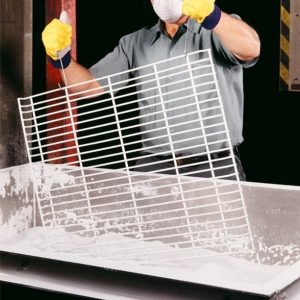How Fluidized Bed Powder Coating Works?

Fluidized bed powder coating is a process of coating a substrate with a fine powder material. The process involves suspending the powder material in a stream of air, creating a fluidized bed of powder that allows for even coating of the substrate. In this article, we will explore how fluidized bed powder coating works.
The process of fluidized bed powder coating can be broken down into five main steps: substrate preparation, powder application, preheating, melting and curing.
Step 1: Substrate Preparation The first step in the fluidized bed powder coating process is substrate preparation. This involves cleaning the substrate to remove any dirt, grease or other contaminants that may prevent the powder from adhering properly. This step is critical to the success of the process, as any contaminants on the substrate can compromise the adhesion and durability of the coating.
Step 2: Powder Application Once the substrate is clean and dry, it is ready for the powder application step. The powder material is typically stored in a hopper or container, where it is metered out using a dispensing device. The dispensing device can be adjusted to control the amount of powder being applied, ensuring that the coating thickness is consistent across the substrate.
Step 3: Preheating After the powder has been applied, the substrate is preheated. This step is necessary to melt the powder and create a uniform coating on the substrate. The temperature of the preheating process will depend on the specific powder material being used, but typically ranges from 180 to 220 degrees Celsius.
Step 4: Melting Once the substrate has been preheated, it is immersed in the fluidized bed of powder. The powder is suspended in a stream of air, creating a fluidized bed that surrounds the substrate. As the substrate is lowered into the fluidized bed, the powder particles adhere to its surface, creating a uniform coating.
The heat from the preheating process causes the powder particles to melt and flow together, forming a continuous film on the substrate. The melting process typically takes between 20 to 30 seconds, depending on the thickness of the coating and the temperature of the fluidized bed.
Step 5: Curing The final step in the fluidized bed powder coating process is curing. Once the coating has been applied, it is heated to a high temperature to cure the powder and create a durable, long-lasting finish. The curing temperature and time will depend on the specific powder material being used, but typically ranges from 150 to 200 degrees Celsius for 10 to 15 minutes.
During the curing process, the powder particles crosslink and chemically react to form a solid, durable coating that adheres to the substrate. The curing process is essential for ensuring the coating’s durability, resistance to abrasion, and chemical resistance.
In conclusion, fluidized bed powder coating is a versatile and efficient method of coating substrates with a fine powder material. The process involves substrate preparation, powder application, preheating, melting, and curing, each of which is critical to the success of the coating. By understanding how fluidized bed powder coating works, you can make informed decisions about whether this process is right for your particular application.

Leave a Reply